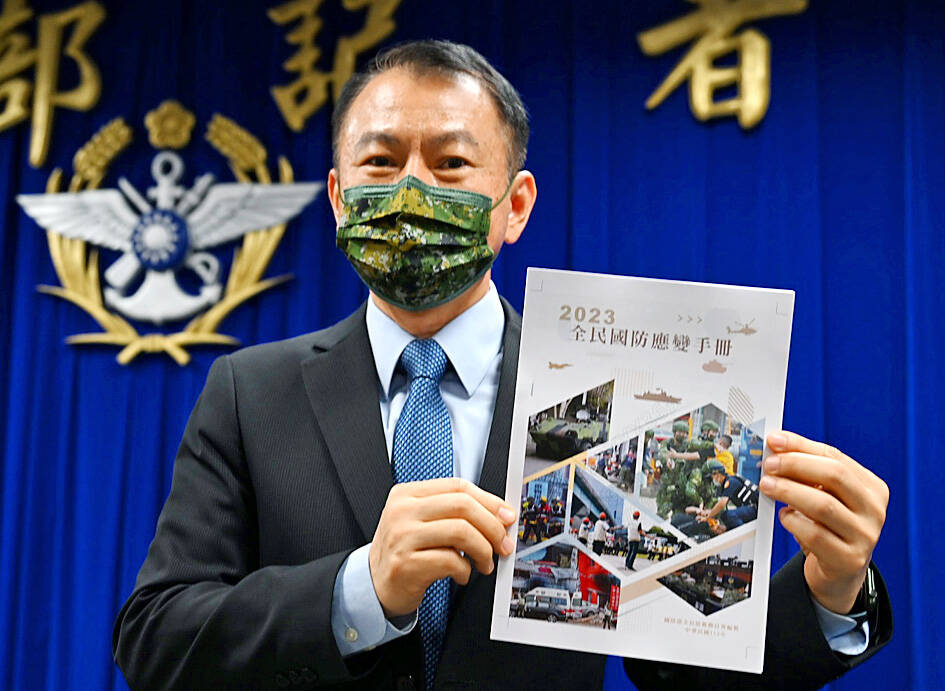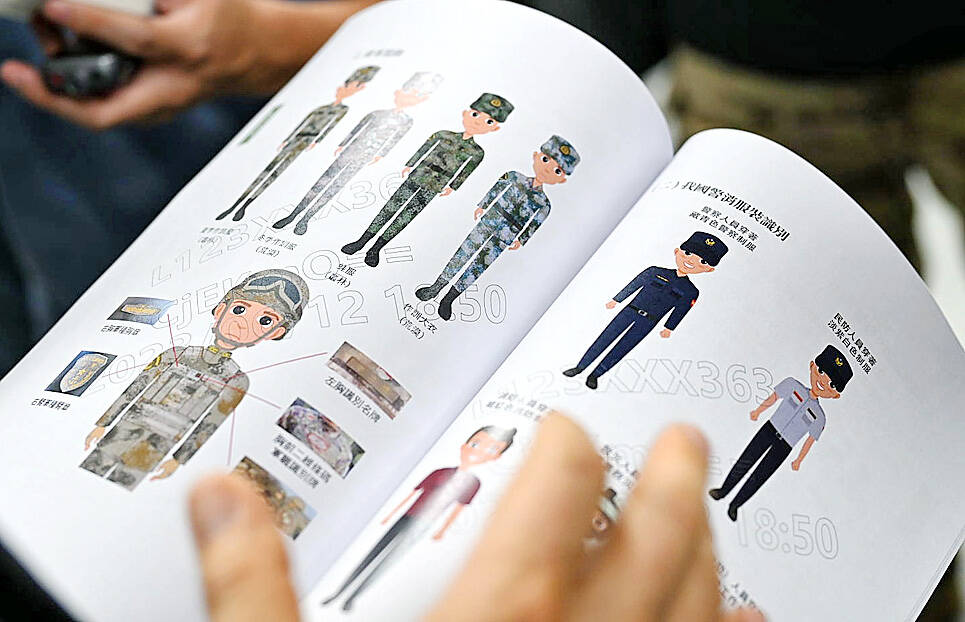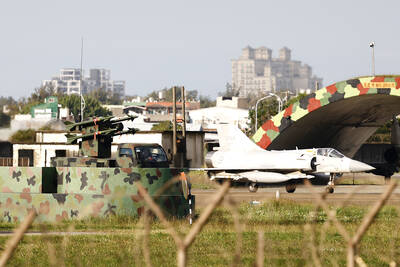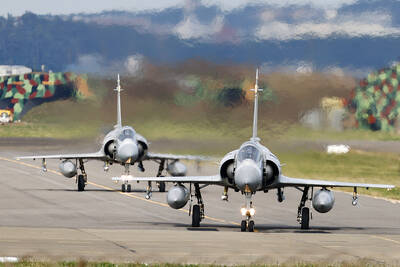A system to discern friend from foe, and instant access to accurate information are among the highlights of the latest version of the All-Out Defense Response Handbook, which the Ministry of National Defense released yesterday.
The ministry presented the handbook at a news conference in Taipei after it spent more than a year revising a version it published in April last year.
The handbook has been expanded from 28 to 48 pages, the ministry said.

Photo: Chang Chia-ming, Taipei Times
All-Out Defense Mobilization Agency Director Shen Wei-chih (沈威志) said that the handbook has two main sections: “Peacetime Preparedness” and “Wartime Response.”
“Peacetime Preparedness” covers items that should be prepared for an emergency evacuation, distinguishing air-raid alerts, knowledge of important facilities and accessing accurate information.
“Wartime Response” covers possible combat situations, including telling friend from foe; conducting an emergency evacuation; handling of water, power or food shortages and other disruptions of daily necessities; addressing communications disruptions; responding to medical emergencies; managing battlefield crises caused by fire, explosives, chemical weapons or missiles; and contacting emergency hotlines.

Photo: Chang Chia-ming, Taipei Times
The handbook shows uniforms and insignia worn by service personnel in Taiwan’s army, navy, air force and Marine Corps, as well as those worn by members of the Chinese People’s Liberation Army (PLA).
“After Russia invaded Ukraine, many have suggested that the handbook should prepare the public for severe wartime situations and offer them adequate information to respond to changes,” Shen said. “As such, we consulted similar books published in other countries, and suggestions proposed by lawmakers and experts to compile the handbook.”
The handbook has information about air-raid shelters, hospitals with emergency rooms and rationing of daily necessities, and allows people to check locations on an app, Shen said.
During wartime, it is important that people do not believe rumors about defeat or surrender by the government, he said.
Nearly 94 percent of the nation’s air defense shelters have been inspected since Aug. 8 last year, the National Police Agency’s Civil Defense and Command Control Center deputy director Lin Kuo-hua (林國華) told the news conference.
Inspections of the remaining shelters should be completed during the first half of next month, Lin said.
Of the 89,405 air defense shelters across Taiwan, 83,691 have been inspected, he said.
“We are in the process of upgrading signs for air defense shelters across the country,” he said.
“Some local governments have been asked to laminate signs to prevent water damage,” he said. “Two regions have printed signs on acrylic panels. Should funding allow, cities and counties are encouraged to use LED panels for the signs.”
As of Wednesday last week, 83.4 percent of the signs had been upgraded, he added.

Taiwan is gearing up to celebrate the New Year at events across the country, headlined by the annual countdown and Taipei 101 fireworks display at midnight. Many of the events are to be livesteamed online. See below for lineups and links: Taipei Taipei’s New Year’s Party 2026 is to begin at 7pm and run until 1am, with the theme “Sailing to the Future.” South Korean girl group KARA is headlining the concert at Taipei City Hall Plaza, with additional performances by Amber An (安心亞), Nick Chou (周湯豪), hip-hop trio Nine One One (玖壹壹), Bii (畢書盡), girl group Genblue (幻藍小熊) and more. The festivities are to

Auckland rang in 2026 with a downtown fireworks display launched from New Zealand’s tallest structure, Sky Tower, making it the first major city to greet the new year at a celebration dampened by rain, while crowds in Taipei braved the elements to watch Taipei 101’s display. South Pacific countries are the first to bid farewell to 2025. Clocks struck midnight in Auckland, with a population of 1.7 million, 18 hours before the famous ball was to drop in New York’s Times Square. The five-minute display involved 3,500 fireworks launched from the 240m Sky Tower. Smaller community events were canceled across New Zealand’s

‘IRRESPONSIBLE’: Beijing’s constant disruption of the ‘status quo’ in the Taiwan Strait has damaged peace, stability and security in the Indo-Pacific region, MOFA said The Presidential Office yesterday condemned China’s launch of another military drill around Taiwan, saying such actions are a “unilateral provocation” that destabilizes regional peace and stability. China should immediately stop the irresponsible and provocative actions, Presidential Office spokeswoman Karen Kuo (郭雅慧) said, after the Chinese People’s Liberation Army (PLA) yesterday announced the start of a new round of joint exercises around Taiwan by the army, navy and air force, which it said were approaching “from different directions.” Code-named “Justice Mission 2025,” the exercises would be conducted in the Taiwan Strait and in areas north, southwest, southeast and east of Taiwan

UNDER WAY: The contract for advanced sensor systems would be fulfilled in Florida, and is expected to be completed by June 2031, the Pentagon said Lockheed Martin has been given a contract involving foreign military sales to Taiwan to meet what Washington calls “an urgent operational need” of Taiwan’s air force, the Pentagon said on Wednesday. The contract has a ceiling value of US$328.5 million, with US$157.3 million in foreign military sales funds obligated at the time of award, the Pentagon said in a statement. “This contract provides for the procurement and delivery of 55 Infrared Search and Track Legion Enhanced Sensor Pods, processors, pod containers and processor containers required to meet the urgent operational need of the Taiwan air force,” it said. The contract’s work would be